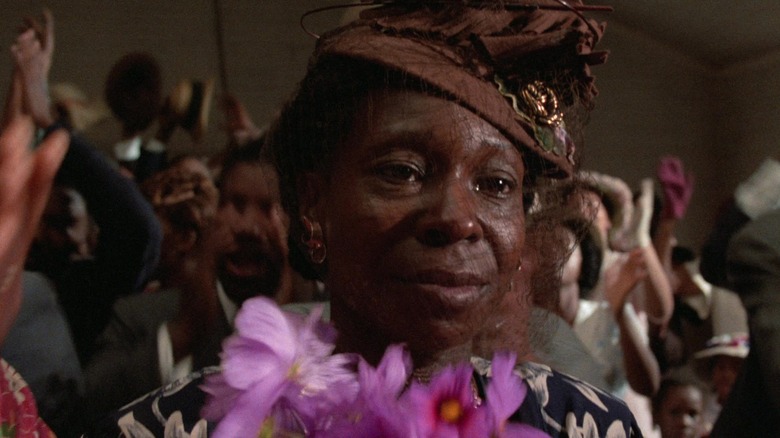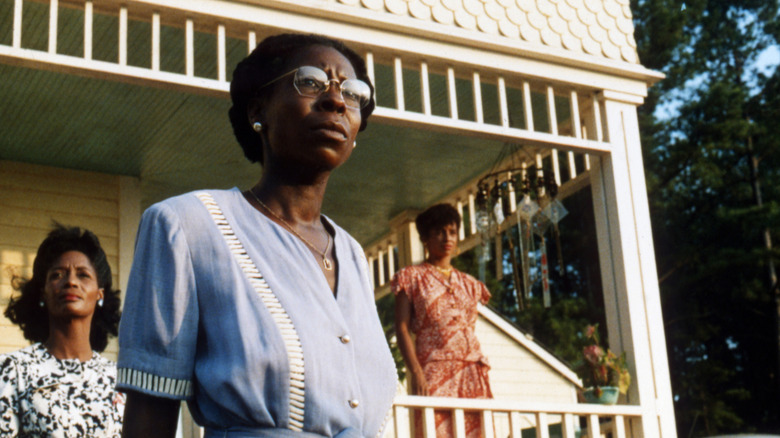A Heartbreaking Steven Spielberg Drama Was Based On A Banned Book
One of my favorite novels is Bohumil Hrabal's "Too Loud a Solitude," and it contains a line I think about every time I read something new: "My briefcase is full of books and that very night I expect them to tell me things about myself I don't know." For while the act of reading is looking inward at someone else's words on a printed page, great writing has the power to expand one's mind and perspective in almost limitless directions. Banning and burning books has the opposite effect, closing things off and denying other people the freedom to explore ideas and make their own minds up.
Sadly, the contentious act of censoring books in the United States has a long and regrettable history reaching back as far as the first European settlers on the continent. One of the earliest examples was William Pynchon's "The Meritorious Price of Our Redemption" from 1650, which was deemed heretical by puritan leaders and burned in New England, leaving only four known copies in existence. Two centuries later, Harriet Beecher Stowe's "Uncle Tom's Cabin" faced similar treatment in states where books denouncing slavery were outlawed. Throughout the 20th Century, some big names have also fallen foul of censorship, including Ernest Hemingway's "A Farewell to Arms" and Anne Frank's "Diary of a Young Girl." Now, book banning is once again a controversial issue in our current political climate. Since 2021, around 16,000 titles have been censored in schools, including bestsellers like Stephen Chbosky's "The Perks of Being a Wallflower," Khaled Hosseini's "The Kite Runner," and, most dystopian of all, Margaret Atwood's landmark novel "The Handmaid's Tale."
Sales figures, critical acclaim, and awards offer little protection from those who wish to curb our reading habits. That was certainly the case with Alice Walker's "The Color Purple," which was adapted into a heartbreaking drama by Steven Spielberg in 1985. Walker's novel was a hit with critics and became a bestseller, going on to win the Pulitzer Prize for fiction and make the author the first Black woman to receive the award in that category. It also became one of the most banned novels in the United States, starting with an attempt to pull it from school bookshelves the year before Spielberg's adaptation was released. Let's take a closer look at the movie and how it holds up.
So, what happens in The Color Purple?
Steven Spielberg's "The Color Purple" is a period drama spanning around 40 years in the life of Celie (Whoopi Goldberg), a mistreated and downtrodden Black woman living in rural Georgia. We first meet her as a young teenager (played by Desretta Jackson in her earlier years) as she is giving birth to her second child by her abusive father. He gives both kids away, and he also hands Celie over to Albert "Mister" Johnson (Danny Glover), a local farmer who belittles and abuses her while treating her like a domestic servant. Celie's beloved sister Nettie (Akosua Busia) briefly joins her at the Johnson household but runs away when Mister tries to force himself on her.
Years later, Celie has ruefully come to accept her lot at the house, unloved by Mister and his children from his previous marriage. She has also given up all hope of once again seeing Nettie, who she assumes is dead. Mister's son Harpo (Willard Pugh) then marries Sofia (Oprah Winfrey), a fierce woman who has no qualms about fighting back against domestic abuse and encourages Celie to do the same. Celie can't quite pluck up the courage, however, and Sofia leaves Harpo and takes the children with her.
Things take a turn with the arrival of Shug Avery (Margaret Avery), a showgirl and Mister's sometime girlfriend, who is suffering from an illness. Celie nurses Shug until she is better again and the pair form a strong bond, toned down from a sexual relationship in the book to just a tender kiss here. Shug asks Celie to go away with her to Memphis, but once again she is unable to find the willpower to walk away from Mister.
Sofia is thereafter imprisoned for striking the white mayor in retaliation for racist abuse and gets released 12 years later, broken and a mere shadow of her former self. Shug then returns with her new husband and hands Celie a letter from Nettie. Together, they discover that Mister has been hiding her mail for a long time, and her sister is alive and well. What's more, Nettie knows the whereabouts of Celie's two children, who were taken away from her when she was so young.
How does Steven Spielberg's The Color Purple hold up?
Alice Walker's "The Color Purple" was first published in 1982, the same year as another book that took a long and winding road to the big screen: "Schindler's Ark." Spielberg postponed making a film version of Thomas Keneally's Booker Prize-winning work until he was mature enough to do it justice. His version of "The Color Purple" proves that putting off "Schindler List" was the right choice.
Spielberg has often been criticized for sentimentality, and those tendencies are at odds with the darker elements of Walker's celebrated novel. The film still touches upon incest, sexual abuse, domestic abuse, and racism, but Spielberg often uncomfortably offsets them with broad comedy. His timid handling of the material combines with Quincy Jones's cloying score and Allan Daviau's picturesque cinematography to bury the tragedies of Celie's life beneath layers of schmaltz.
Having said that, "The Color Purple" still works almost in spite of Spielberg's involvement. This is down to the staying power of Walker's tale and some outstanding performances, especially from Goldberg as Celie. It was a gamble casting a comic performer with almost zero film experience in the role, but Goldberg gives a captivating portrayal of a downtrodden woman who has managed to retain her sense of dignity and quiet amusement over many years of servitude and humiliation. Almost as good is Winfrey in her film debut, dominating every moment of her limited screen time as Sofia; meanwhile, Avery radiates self-confidence and compassion as Shug. All three women deservedly received Oscar nominations, and they carry the story high on their shoulders to the cathartic ending (which would have been arguably even more joyous if Spielberg hadn't soft-peddled the hardship and heartache the characters go through to get there).
Overall, "The Color Purple" is a handsomely made but very flawed prestige picture that is hampered by its creatives' twee approach. But despite the criticism Spielberg received, the film was a box office hit, and it helped cement the legacy of Walker's work. For all the censorship challenges, Walker's novel remains one of America's best-loved books, and it also inspired a 2005 musical and a well-meaning 2023 film based on the stage production. As Bohumil Hrabal also wrote, "If a book has anything to say, it burns with a quiet laugh, because any book worth its salt points up and out of itself."


